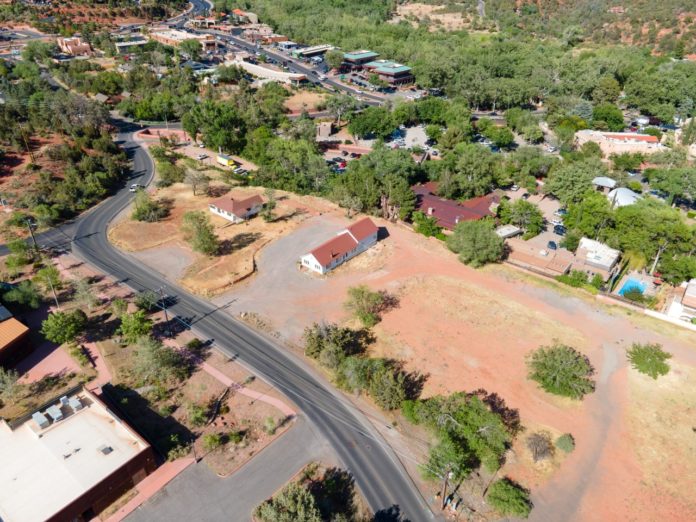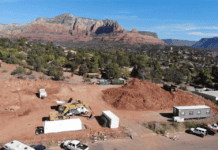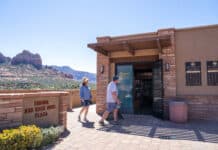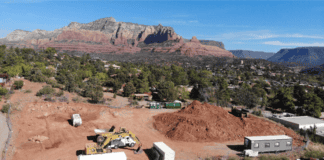
As a result of this year’s spring break crowds, which brought an increase in traffic and parking issues at area trailheads, the city is looking to do something about it — several years ahead of schedule.
The Sedona City Council on May 11 gave direction to staff to proceed with plans council members think may serve as a temporary fix to the above problem. While the overall transit plan will take several years to implement, Robert Weber, the city’s first-ever transit administrator, feels there are things that can be done in the meantime.
“From a transit standpoint, that is quite a footprint — it’s quite an area to cover,” he said, showing a map of the proposed transit routes. “So, anything we deploy [buses], we’re going to want to start from a central point as much as possible.”
The proposal is to have three trailhead shuttle routes. Route A, with stops every hour, include Sedona Cultural Park and the Girdner, Dry Creek and Mescal trails. Route B, with two buses, each stopping every 30 minutes, would include Soldier Pass and Grasshopper Point, while Route C, also two buses every 30 minutes, lists Huckaby, Cathedral Rock and Little Horse trails.
Staff also proposed a temporary trailhead shuttle exchange, which would be located on the city-owned Ranger Station Park on Brewer Road. The permanent transit hub, which isn’t expected to be built for at least another three years, is being proposed further west off 89A near Brewer Road.
Weber said the Ranger Station location is suitable for now because of its convenience, it’s centrally-located and its connectivity to State Routes 179 and 89A. The proposed schedule would see the busses running year-round Thursdays through Sundays from 8 a.m. to 5:30 p.m., with additional days during spring break and certain holidays.
“These limited hours of operation are being recommended to control expenditures while providing service during peak traffic periods,” a city report states. “This span of service will also offer a model that will allow the contractor [which will operate and maintain the buses] to recruit and retain qualified personnel to operate the service. Additionally, the service would operate daily during specific holiday weeks to include March spring break.”
In order to get people to the trailheads, the city proposes purchasing five buses, each capable of carrying more than 20 passengers each. But the difficult decision facing the city is what type of bus to buy because prices vary greatly. For example, Weber said the base cost for a gas-powered bus, without any additional upgrades, is around $94,000. A base hybrid cost is around $120,000, but the price tag jumps dramatically for battery electric busses at $375,000.
Also included in this initial plan is the use of what’s called microtransit, which uses smaller buses or vans capable of carrying eight to 10 passengers. Using a phone app, users could request the shuttle to pick them up at area resorts and drop them off at the trailhead shuttle exchange. The overall goal is to get people out of their cars and reduce the number of vehicles at area trailheads.
The timeline for implementation is intended to have these services fully operational within a year. Milestones over the next year include:
■ May 2021: Finalize service schedules, trailhead stops and the U.S. Forest Service Special Use Application, complete microtransit simulations/predictive modeling.
■ June 2021: Publish service provider Request For Proposals.
■ September 2021: Award service contract; finalize marketing plans and materials including vehicle branding design, fare policies, fare media and pass programs.
■ November 2021: Procure vehicles, communications platform, digital fare collection system.
■ March 2022: Deploy service.
“Ninety days ago Robert had just been hired to implement a transit plan that contemplated the very first phase — which was trailhead shuttles and the core routes — four years from now,” City Manager Karen Osburn said.
“He was hired to start all of the work, toward all of the moving pieces to get those systems in place. We’ve been talking about the oversubscription at the trailheads, the issues it’s creating in neighborhoods, but within a week or two of Robert being hired I said, ‘What do you think about aggressively pursuing the trailhead piece of the system and getting it up and running by next spring?’ It’s a colossal undertaking and it’s super ambitious. But this is where he is after a very short period of time.”
Osburn added, “We are very early on in this process. But if we’re going to do something to relieve these issues that we’re seeing, we have to start somewhere.”



















